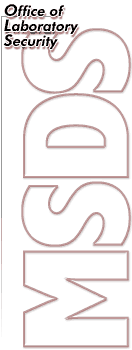

  |
|||||||||||||||||

|
MATERIAL SAFETY DATA SHEET - INFECTIOUS SUBSTANCES SECTION I - INFECTIOUS AGENT NAME: Venezuelan equine encephalitis virus SYNONYM OR CROSS REFERENCE: Venezuelan equine encephalomyelitis, VEE, Venezuelan equine fever, arbovirus CHARACTERISTICS: Togaviridae, alphavirus; 70 nm diameter, ssRNA, enveloped; enzootic subtypes and epizootic varieties of subtype 1 SECTION II - HEALTH HAZARD PATHOGENICITY: Influenza-like manifestations; abrupt onset of severe headache, chills, fever, myalgia, retro-orbital pain, nausea and vomiting; conjunctival and pharyngeal injection; most infections mild with symptoms 3-5 days; some cases have diphasic fever, CNS involvement, encephalitis with disorientation, convulsions, paralysis, coma and death EPIDEMIOLOGY: Endemic in northern South America, Trinidad, Central America, Mexico and Florida; appear as epizootics principally in Northern and Southwestern America; in 1970-71, spread through Central America into the USA; children are at greatest risk for developing CNS infections HOST RANGE: Humans, horses INFECTIOUS DOSE: 1 viral unit - subcutaneous MODE OF TRANSMISSION: Bite of infected mosquito; laboratory infections by aerosols are common; no evidence of transmission from horses to humans INCUBATION PERIOD: Usually 2-6 days, can be as short as 1 day COMMUNICABILITY: Human cases are infectious for mosquitoes for 72 hours; mosquitoes are infectious for life; person-to-person transmission may occur but has not been demonstrated SECTION III - DISSEMINATION RESERVOIR: Rodent-mosquito cycle maintains the enzootic subtypes; epizootic subtypes transmitted in cycles involving horses, mosquitoes, humans ZOONOSIS: Yes, from infected horses via mosquitoes VECTORS: Mosquitoes - Culex (Melanoconion), Aedes, Mansonia, Psorphora, Haemogogus, Deinocerites, Sabethes, Anopheles SECTION IV - VIABILITY DRUG SUSCEPTIBILITY: N/A SUSCEPTIBILITY TO DISINFECTANTS: Susceptible to disinfectants - 1% sodium hypochlorite, 70% ethanol, 2% glutaraldehyde, formaldehyde PHYSICAL INACTIVATION: Inactivated by moist and dry heat; drying SURVIVAL OUTSIDE HOST: Virus is present in pharyngeal secretions and is stable when aerosolized; stable in dried blood and exudates SECTION V - MEDICAL SURVEILLANCE: Monitor for symptoms; confirm by virus isolation, antibody titre FIRST AID/TREATMENT: No specific treatment IMMUNIZATION: Investigational attenuated virus vaccine and inactivated vaccine are available and recommended for all personnel working with VEE, infected animals or entering rooms where these agents or infected animals are present PROPHYLAXIS: None SECTION VI - LABORATORY HAZARDS LABORATORY-ACQUIRED INFECTIONS: 150 reported laboratory infections with 1 death; eighth most commonly reported laboratory infection SOURCES/SPECIMENS: Blood, nasopharyngeal specimens, CSF, urine PRIMARY HAZARDS: Exposure to aerosols of infectious solutions and animal's bedding, accidental parenteral inoculation, broken skin contact
SPECIAL HAZARDS: Virus is stable in dried blood or exudates SECTION VII - RECOMMENDED PRECAUTIONS CONTAINMENT REQUIREMENTS: Biosafety level 3 practices (with vaccination), containment equipment, and facilities for activities using potentially infectious clinical materials and infected tissue cultures, animals or arthropods PROTECTIVE CLOTHING: Laboratory coat; gloves and gown with ties in back and tight wrists when working with agent OTHER PRECAUTIONS: HEPA filtration of all exhaust air prior to discharge; vaccination of workers SECTION VIII - HANDLING INFORMATION SPILLS: Allow aerosols to settle; wearing protective clothing (respirator), gently cover spill with paper towel and apply l% sodium hypochlorite, starting at perimeter and working towards the centre; allow sufficient contact time before clean up (30 min) DISPOSAL: Decontaminate before disposal; incineration, steam sterilization STORAGE: In sealed containers that are appropriately labelled (in locked level 3 facility) SECTION IX - MISCELLANEOUS INFORMATION Date prepared: May, 2001 Prepared by: Office of Laboratory Security, PHAC Although the information, opinions and recommendations contained in this Material Safety Data Sheet are compiled from sources believed to be reliable, we accept no responsibility for the accuracy, sufficiency, or reliability or for any loss or injury resulting from the use of the information. Newly discovered hazards are frequent and this information may not be completely up to date. Copyright © [Material Safety Data Sheets - Index]
|
| Last Updated: 2001-09-25 | |||